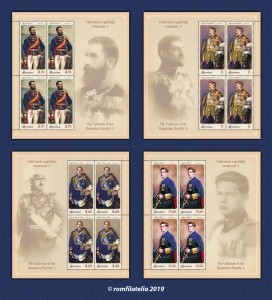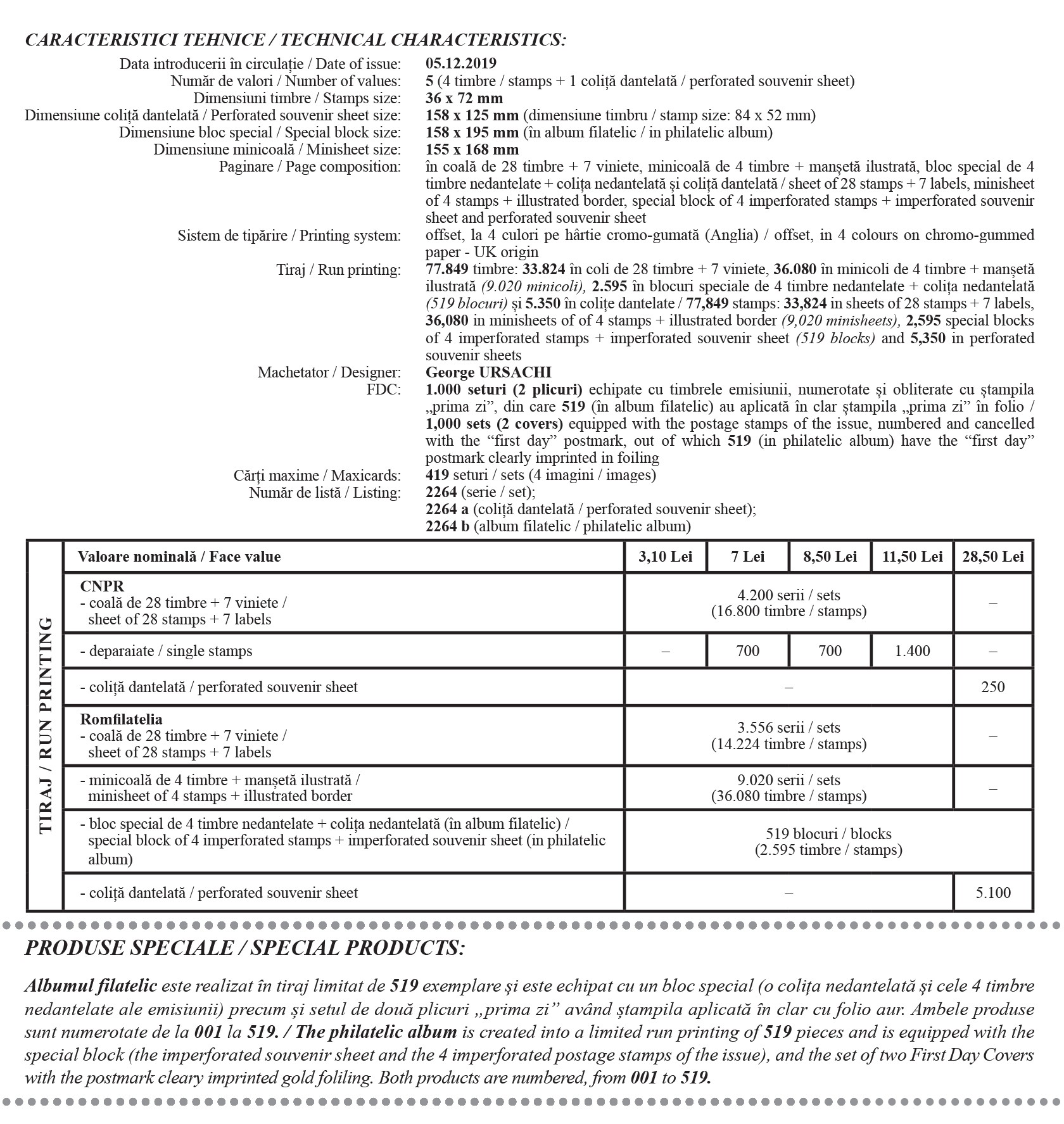 As a sign of recognition of the importance of the Romanian Royal family for the history of Romania, both from political and military point of view, Romfilatelia dedicates “the Uniforms of the Romanian Royalty (I)” postage stamps issue, which will be introduced into circulation on December 5th, being composed of 4 stamps and a perforated souvenir sheet, bringing together all the kings of Romania.
As a sign of recognition of the importance of the Romanian Royal family for the history of Romania, both from political and military point of view, Romfilatelia dedicates “the Uniforms of the Romanian Royalty (I)” postage stamps issue, which will be introduced into circulation on December 5th, being composed of 4 stamps and a perforated souvenir sheet, bringing together all the kings of Romania.
Promoter and ambassador of the country, the stamp is more than a product, it represents image, tradition, history, cultural identity, and the journeys through this symbol offer fascinating stories about the past, present and why not, about future.
The most recent postage stamps issue presents an impressive part of the national history – respectively that of the Royalty in Romania and the way the military tradition has interwoven with the monarchy.
Since its establishment in Romania in 1881, the monarchy has been characterized by the presence of five symbols of the Romanian Royalty (or the regalia of Romania): the Royal crown, the sceptre, the Royal mantle, the Royal flag and the Royal cypher. However, if there was a specific element to all the representations of the portraits of the Kings of Romania, that was the presence of the Royal uniform, worn with dignity by Carol I, Ferdinand I “the Unifier”, Carol II, and Mihai I.
The investiture of King Carol I coincided with the end of the period of pompous French influence uniforms, a sober, economic and simpler outfit being adopted, not lacking in elegance, but adapted to the financial resources of Romania of that period. Since his arrival on the throne, King Carol I has adopted as official dress, the officers’ uniform, also opting to wear the military uniform in the private meetings with Romanian politicians.
On the stamp with the face value of Lei 3.10, King Carol I (1839 – 1914) is illustrated, the Ruler of the Romanian Principalities (1866) and the First King of Romania (1881), member and honorary president of the Romanian Academy. The reign of King Carol I was the longest in the country’s history. The 48 years have seen the military actions for the country’s independence, the transformation into a constitutional monarchy and the initiation of the consolidation of the modern Romanian State, always being acted in such a way as to ensure the international prestige of the State.
Prince Carol I preferred to appear en petite tenue uniform in almost all circumstances, except for special events, when the protocol required being en grande tenue uniform.
King Ferdinand I (1865 – 1927) is represented on the stamp with the face value of Lei 7. The King also known as Ferdinand I the Unifier, King of Greater Romania (“from the Dniester to the Tisza”), as well as a member and honorary president of the Romanian Academy.
Deciding to enter the war in 1916 on the side of the Antante, he had a special role in the events that preceded the Reunification of the Country and contributed decisively to the end of the war, in August 1919, when all the conditions for the recognition of Greater Romania were ensured.
During his reign, the unitary Romanian national State was consolidated and fundamental measures were adopted for the development of the country, such as the universal vote and the agrarian reform.
King Ferdinand I wore the Royal uniform even at private meetings. After the war, the King adopted a “civilian” outfit at court meetings, at official ceremonies opting for the military outfit.
On the stamp with the face value of Lei 8.50 is depicted King Carol II (1893 – 1953), the King of Romania and honorary member of the Romanian Academy.
Although he relinquished his prerogatives as heir to the Crown several times, and his reign did not lack controversy, during his rule Romania experienced the greatest economic advance of the interwar period.
Characterized by the permanent conflicts between the King and the political class, the monarchic institution grew in to play the most important role in the State, establishing in Romania an authoritarian monarchic regime, following the model of several European States during that period.
The period in which the greatest changes took place was during the reign of King Carol II. As a child, Carol II appeared dressed in military uniform, in the spirit of the Romanian monarchy. At all the official ceremonies, the King appeared in military dress, with a beret and marshal’s cape.
Fascinated by the elegance of the English military uniforms, Carol II modernized the design of the garments of the Romanian military. The most spectacular changes were those in the field of full and ceremony dress, starting with the year 1930.
The abdication of King Carol II changed the vision on military uniforms with that addressed by Marshall Ion Antonescu and King Mihai I (who began wearing military uniform as a child, at the request of his father).
The stamp with the face value of Lei 11.50, King Mihai I (1921 – 2017) is portrayed, the last King of Romania. His first reign was inaugurated at the age of 6, when his father relinquished the prerogatives of heir to the Crown. His second reign began in one of the most dramatic moments in Romania’s history, following the territorial losses of 1940. Mihai I led the country in a critical period with Ion Antonescu, General of the Romanian Army and the president of the Council of Ministers.
The dismissal of Ion Antonescu on August 23rd, 1944 was King Mihai’s choice, who ordered his arrest, the immediate cessation of Romania’s cooperation with the Axis Powers and the orientation towards an armistice with the Allies.
On December 30th, 1947, King Mihai I abdicated, being forced to do so by the leadership established by the Romanian Communist Party, which, after three years past the end of the war, had seized the entire political power in the State.
The postage stamps issue is complemented by a imperforated souvenir sheet, as a homage to the 180 year anniversary since the birth of King Carol I, the stamp depicting him in a painting riding in a military uniform, with a face value of 28.50 Lei.
On the First Day Cover is illustrated the paining “King Carol and his suite”, by Carol Popp de Szathmáry a chromolithography from the vast work of the first Romanian art photographer.
Romfilatelia thanks the Peles National Museum, the Romanian Academy Library, the Royal House of Romania, the National Museum of Art of Romania, the National History Museum of Romania, The Cotroceni National Museum and the Museum of Bucharest, for the documentary support given in achieving this postage stamps issue.



